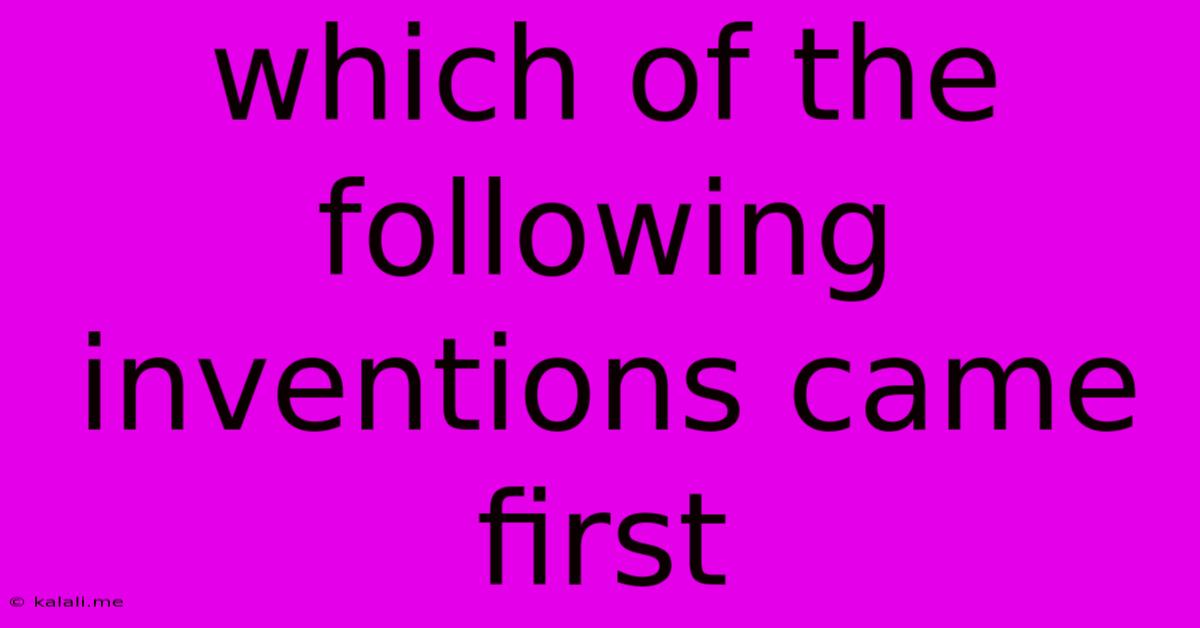Which Of The Following Inventions Came First
Kalali
Jun 13, 2025 · 3 min read

Table of Contents
Which Invention Came First? A Journey Through History's Innovations
This article delves into the fascinating world of historical inventions, tackling the age-old question: which invention came first? We'll explore several pivotal innovations, examining their timelines and the impact they had on society. This isn't just a simple quiz; it's a journey through the evolution of human ingenuity. Understanding the order of these inventions sheds light on how technological advancements build upon each other, shaping the world we live in today.
A Note on Defining "First": It's crucial to understand that pinpointing the exact "first" invention is often difficult. Early innovations may have been rudimentary, undocumented, or lost to history. We'll focus on the earliest widely recognized and impactful versions of these inventions.
The Contenders: A Trio of Transformative Technologies
We'll focus on three inventions that significantly impacted human civilization: the printing press, the telescope, and the light bulb. Understanding their chronological order provides a unique perspective on the progression of scientific and technological development.
1. The Printing Press: The invention of the printing press is often attributed to Johannes Gutenberg around the mid-15th century. Before this, books were painstakingly hand-copied, making them incredibly expensive and rare. Gutenberg's movable type printing press revolutionized information dissemination, making books more accessible and fueling the Renaissance and the Scientific Revolution. This marked a pivotal shift towards mass communication and the widespread distribution of knowledge. Think of the impact on literacy rates and the spread of new ideas – truly transformative. The increased availability of information directly impacted subsequent scientific and technological progress.
2. The Telescope: While rudimentary magnifying devices existed earlier, the invention of the refracting telescope is generally credited to Hans Lippershey in the early 17th century. Lippershey's invention, though simple compared to modern telescopes, allowed for the observation of celestial objects with unprecedented clarity. This invention opened up the universe for exploration, leading to groundbreaking astronomical discoveries and fundamentally altering our understanding of the cosmos. The telescope dramatically advanced our understanding of the universe and laid the groundwork for future astronomical advancements.
3. The Light Bulb: The incandescent light bulb, as we know it, wasn't a single invention but a process of gradual improvement. While many inventors contributed, Thomas Edison is largely credited with creating the first commercially successful incandescent light bulb in the late 19th century. Edison's invention revolutionized daily life, extending the workday and providing a safer, more convenient alternative to gaslight and candles. The impact on productivity, safety, and social life was profound. The light bulb’s invention marked a significant step towards electrification and modernization across the globe.
The Verdict: Establishing the Chronological Order
Based on the historical evidence, the correct order of these inventions is:
- Printing Press (mid-15th century)
- Telescope (early 17th century)
- Light Bulb (late 19th century)
This chronological order highlights the interconnectedness of innovation. The increased availability of information facilitated by the printing press likely contributed to the scientific advancements that led to the telescope. And the societal changes brought about by both the printing press and the telescope paved the way for the development and widespread adoption of the light bulb.
This journey through the history of these three inventions underscores the importance of understanding the progression of technology and the enduring impact these innovations have had on shaping the modern world. It's a testament to human ingenuity and the power of continuous improvement. Each invention built upon the progress of its predecessors, a clear illustration of the cumulative nature of technological advancement.
Latest Posts
Latest Posts
-
Common Factors For 84 And 105
Jun 14, 2025
-
Which Color Is Not A Primary Color
Jun 14, 2025
-
What Is The Difference Between A Square And Rhombus
Jun 14, 2025
-
The Normal Rbc Graveyard Is The Liver
Jun 14, 2025
-
Can You Reschedule A Sat Test
Jun 14, 2025
Related Post
Thank you for visiting our website which covers about Which Of The Following Inventions Came First . We hope the information provided has been useful to you. Feel free to contact us if you have any questions or need further assistance. See you next time and don't miss to bookmark.